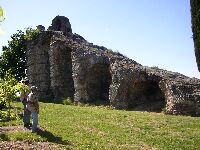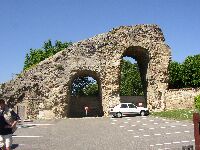


Siphons
One way by which natural features such as valleys and depressions could be crossed was the inverted siphon, a technique based on the simple physical principle that "water finds its own level". The Romans were well aware of this principle, as Pliny puts it - (Hist. Nat. 21.57). They took advantage of this fact by constructing pipes reaching to the tops of high fountains and to supply the upper rooms of houses (Middleton, 1892:316). On occasion the Romans would cross the lowest portion of a valley on a bridge, whether to reduce water pressure that increased with the vertical drop of the pipe, or to form a level and sturdy bed (Aicher, 1995:17).Just before a downward slope, water was collected into a reservoir, from which a pipe carried it to the bottom of the hollow by gravity, and then up again into a second reservoir, thanks to the pressure generated along the first slope. A small viaduct was sometimes built on the bottom of the hollow to reduce its maximum height, thus to minimize the water pressure needed to climb the opposite side. The illustration shows of such a siphon.
The other illustration shows a reservoir on the Aqua Marcia, near the villa Vignacce with the Marcia, Tepula and Julia in the background, near the Via Lemonia.
Note that this section conducts water from the Acqua Felice. This aqueduct was completed by Pope Sixtus V in 1586, and was the first new aqueduct of early Modern Rome. It is 24 km long, running underground for almost 13 km from its source, first in the channel of Aqua Alexandrina, then alternating on the arches of the Aqua Claudia and Aqua Marcia for 11 km to its terminus at the Fountain of Moses on the Quirinal Hill.
Many modern sources state that the siphon was not often used for Roman aqueducts, and give a number of reasons for this. For example, pipes available in Roman times, made of lead or earthenware, could not be soldered steadily enough to hold the rather strong pressure generated by the slope, causing a substantial loss of water and requiring frequent repairs. Another example often mentioned is that they did not know of its existence. Some modern sources even state that the Romans had failed to realise that "water finds its own level". However, it is clear from the writing of Archimedes, Hero and Vitruvius that the Greeks and Romans had a thorough grasp of the pressure-equilibrium principle (Landels, 2000:43), if not from their engineering accomplishments.
As Hodge (2002:147) points out, the Romans did in fact use inverted siphons. They were both numerous and successful, see website. Hodge gives two possible reasons why modern scholars often write as if the Romans did not use them. Firstly, there might be ignorance of evidence, arising from the circumstance that siphons are very rare on the Rome metropolitan network, and this is where study has been concentrated. The second is a misapprehension of the hydraulics involved, in particular what Vitruvius has to say about them. Vitruvius said that siphons create pressure and steps have to be taken to deal with it. This is then garbled into statements that Romans tried to avoid pressure systems, and sometimes that they did avoid them and that such systems did not exist. Middleton (1892:316) states that the reason the Roman engineers did not use the siphon often was economical: lead and bronze were very expensive and had to be brought from some distance away. The amount of lead needed to manufacture an inverted siphon is considerable. Hauck (1988) states that one of the reasons for building the Pont du Gard may have been because of the prohibitive cost of purchasing and transporting enough lead to build enough inverted siphons to carry that amount of water. Middleton also points out that it is convenient to employ channels which were readily accessible for maintenance purposes. Nota that the Croton Aqueduct in New York, constructed between 1837 and 1842, was similar to the Roman aqueducts in many ways. It also did not employ siphons for the reason of cost. Landels (2000:43) states that siphons are more difficult to construct and require specialised skills. He also states that the lead pipes were more prone to bursts and leakage, and the conduit itself was not accessible in case of blockage. Sections or entire pipes would have to be replaced.
The architects, instead, in most cases preferred to lengthen the course of the aqueduct, sometimes quite considerably (as in the case of the Aqua Virgo), so to follow the ground's natural features and constantly meet a regular slope. This, according to Frontinus, is the reason why most aqueducts were much longer than the direct distance between their source and their urban output. Middleton (1892:317) finds this description unsatisfactory. He states that step-like falls of water could have been arranged at required points along the course of the aqueduct, and would have shortened the length considerably.
There is additional evidence against the commonly believed that the Romans did not make use of siphons. The Beaunant siphon of the Gier aqueduct serving Lyon had a drop of 123 metres and was 2.6 kilometres long (Aicher, 1995:17). What is true is that there is little evidence for their use in Rome itself, though Ashby (1935) does point out that the Capitoline and Palatine Hills were supplied by siphon. Evans and Bruun are in agreement with this. Evans (2000:90) states that the Marcia's higher level made delivery of water to the Palatine possible, and that it is probable a siphon was used.
From the thesis of Evan J. Dembskey on The aqueducts of Ancient Rome